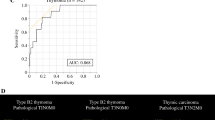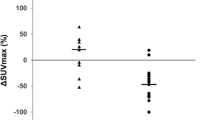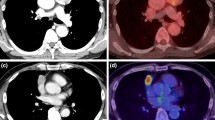Abstract
Objective
Thymic squamous cell carcinoma (TSCC) is very rare. This study aims to investigate the clinical utility of fluorine-18-fluorodeoxyglucose positron emission tomography/computed tomography (18F-FDG PET/CT) in treatment-naive patients with TSCC.
Methods
The tumor metabolic parameters of 18F-FDG PET/CT, including maximum standard uptake value (SUVmax), metabolic tumor volume of primary lesion (MTV-P) and combination of primary lesion and metastases (MTV-C), and total lesion glycolysis of primary lesion (TLG-P) and combination of primary lesion and metastases (TLG-C) were collected. Age, sex, smoking, serum tumor markers, tumor size, Masaoka-Koga stage, TNM stage, contrast-enhanced CT scan, and tumor immunity were also reviewed. Moreover, progression-free survival (PFS) and overall survival (OS) of these patients were analyzed.
Results
Forty-two treatment-naive patients with TSCC were enrolled in this study. All primary tumors were FDG-avid with the average SUVmax of 10.0 ± 4.5 (range, 1.5–20.4). Higher SUVmax, MTV-C, and TLG-C were observed in advanced Masaoka-Koga stage than early stage, and higher SUVmax was found in advanced TNM stage than early stage. Next, 36 out of 42 patients performed chest contrast-enhanced CT scan, which showed SUVmax associated with the enhancement degree of CT. Moreover, 27 out of 42 lesions were assessed tumor immunity, and the detective rates of PD-L1, PD-1, CD4, CD8, and Foxp3 were 59.3%, 37.0%, 59.3%, 100%, and 77.8%, respectively. Higher SUVmax was observed in lesions with lower CD4-positive tumor-infiltrating lymphocytes. Furthermore, 12- and 24-month PFS and OS rates were 62.0% vs 32.8% and 84.5% vs 68.9%, respectively. Multivariate Cox regression analysis showed that only MTV-C was an independent predictor of PFS.
Conclusion
18F-FDG PET/CT is useful in evaluating tumor staging, assessing CT enhancement degree, and detecting tumor immunity of TSCC before treatment. 18F-FDG PET/CT could also be a promising tool to provide prognostic information for treatment-naive patients with TSCC.




Similar content being viewed by others
References
Riedel RF, Burfeind WRJ. Thymoma: benign appearance, malignant potential. Oncologist. 2006;11:887–94.
Zhao Y, Zhao H, Hu D, Fan L, Shi J, Fang W. Surgical treatment and prognosis of thymic squamous cell carcinoma: a retrospective analysis of 105 cases. Ann Thorac Surg. 2013;96:1019–24.
Ruffini E, Detterbeck F, Van Raemdonck D, Rocco G, Thomas P, Weder W, et al. Thymic carcinoma: a cohort study of patients from the European society of thoracic surgeons database. Lung Cancer. 2014;9:541–8.
Ahmad U, Yao X, Detterbeck F, Huang J, Antonicelli A, Filosso PL, et al. Thymic carcinoma outcomes and prognosis: results of an international analysis. J Thorac Cardiovasc Surg. 2015;149:95–101.
Kelly RJ, Petrini I, Rajan A, Wang Y, Giaccone G. Thymic malignancies: from clinical management to targeted therapies. J Clin Oncol. 2011;29:4820–7.
Cafaro A, Bongiovanni A, Di Iorio V, Oboldi D, Masini C, Ibrahim T. Pembrolizumab in a patient with heavily pre-treated squamous cell thymic carcinoma and cardiac impairment: a case report and literature review. Front Oncol. 2020;10:1478.
Yu B, Zhu X, Liang Z, Sun Y, Zhao W, Chen K. Clinical usefulness of (18)F-FDG PET/CT for the detection of distant metastases in patients with non-small cell lung cancer at initial staging: a meta-analysis. Cancer Manag Res. 2018;10:1859–64.
Kandathil A, Kay FU, Butt YM, Wachsmann JW, Subramaniam RM. Role of FDG PET/CT in the eighth edition of TNM staging of non-small cell lung cancer. Radiographics. 2018;38:2134–49.
Kanyilmaz G, Benli Yavuz B, Aktan M, Sahin O. Prognostic importance of (18)F-fluorodeoxyglucose uptake by positron emission tomography for stage III non-small cell lung cancer treated with definitive chemoradiotherapy. Rev Esp Med Nucl Imagen Mol. 2020;39:20–6.
Jadvar H, Alavi A, Gambhir SS. 18F-FDG uptake in lung, breast, and colon cancers: molecular biology correlates and disease characterization. J Nucl Med. 2009;50:1820–7.
Lv Z, Fan J, Xu J, Wu F, Huang Q, Guo M, et al. Value of (18)F-FDG PET/CT for predicting EGFR mutations and positive ALK expression in patients with non-small cell lung cancer: a retrospective analysis of 849 Chinese patients. Eur J Nucl Med Mol Imaging. 2018;45:735–50.
Wu X, Huang Y, Zhao Q, Wang L, Song X, Li Y, et al. PD-L1 expression correlation with metabolic parameters of FDG PET/CT and clinicopathological characteristics in non-small cell lung cancer. EJNMMI Res. 2020;10:51.
Wu X, Huang Y, Li Y, Wang Q, Wang H, Jiang L. (18)F-FDG PET/CT imaging in pulmonary sarcomatoid carcinoma and correlation with clinical and genetic findings. Ann Nucl Med. 2019;33:647–56.
Xie Y, Zhang S, Liu J, Liang X, Zhang X, Zhang Y, et al. Value of CT spectral imaging in the differential diagnosis of thymoma and mediastinal lymphoma. Br J Radiol. 2019;92:20180598.
Filosso PL, Ruffini E, Lausi PO, Lucchi M, Oliaro A, Detterbeck F. Historical perspectives: The evolution of the thymic epithelial tumors staging system. Lung Cancer. 2014;83:126–32.
Masaoka A, Monden Y, Nakahara K, Tanioka T. Follow-up study of thymomas with special reference to their clinical stages. Cancer. 1981;48:2485–92.
Koga K, Matsuno Y, Noguchi M, Mukai K, Asamura H, Goya T, et al. A review of 79 thymomas: modification of staging system and reappraisal of conventional division into invasive and non-invasive thymoma. Pathol Int. 1994;44:359–67.
Detterbeck FC, Stratton K, Giroux D, Asamura H, Crowley J, Falkson C, et al. The IASLC/ITMIG Thymic Epithelial Tumors Staging Project: proposal for an evidence-based stage classification system for the forthcoming (8th) edition of the TNM classification of malignant tumors. J Thorac Oncol. 2014;9:S65-72.
Lococo F, Cesario A, Okami J, Cardillo G, Cavuto S, Tokunaga T, et al. Role of combined 18F-FDG-PET/CT for predicting the WHO malignancy grade of thymic epithelial tumors: a multicenter analysis. Lung Cancer. 2013;82:245–51.
Ito T, Suzuki H, Sakairi Y, Wada H, Nakajima T, Yoshino I. 18F-FDG-PET/CT predicts grade of malignancy and invasive potential of thymic epithelial tumors. Gen Thorac Cardiovasc Surg. 2021;69:274–81.
Ishibashi M, Tanabe Y, Yunaga H, Miyoshi H, Miwa K, Nakamura H, et al. Usefulness of preoperative (18)F-FDG PET/CT for patients with thymic epithelial tumors. Yonago Acta Med. 2019;62:146–52.
Park SY, Cho A, Bae MK, Lee CY, Kim DJ, Chung KY. Value of 18F-FDG PET/CT for predicting the world health organization malignant grade of thymic epithelial tumors: focused in volume-dependent parameters. Clin Nucl Med. 2016;41:15–20.
Kaba E, Ozkan B, Erus S, Duman S, Cimenoglu B, Toker A. Role of surgery in the treatment of Masaoka stage IVa thymoma. Ann Thorac Cardiovasc Surg. 2018;24:6–12.
Zhonggao J, YiJiao W, Yongfeng W, Zhitao P, Jun W, Diansheng L, et al. Multislice computed tomography performance in differential diagnosis of high-density thymic cyst and thymoma in lesions less than 3 cm. Thorac cancer. 2018;9:1300–4.
Zhao Y, Chen H, Shi J, Fan L, Hu D, Zhao H. The correlation of morphological features of chest computed tomographic scans with clinical characteristics of thymoma. Eur J cardio-thoracic Surg. 2015;48:698–704.
Sung YM, Lee KS, Kim B-T, Choi JY, Shim YM, Yi CA. 18F-FDG PET/CT of thymic epithelial tumors: usefulness for distinguishing and staging tumor subgroups. J Nucl Med. 2006;47:1628–34.
Nakajo M, Kajiya Y, Tani A, Yoneda S, Shirahama H, Higashi M, et al. 18FDG PET for grading malignancy in thymic epithelial tumors: significant differences in 18FDG uptake and expression of glucose transporter-1 and hexokinase II between low and high-risk tumors: preliminary study. Eur J Radiol. 2012;81:146–51.
Yokoyama S, Miyoshi H. Thymic tumors and immune checkpoint inhibitors. J Thorac Dis. 2018;10:S1509–15.
Kim KH, Hur JY, Cho J, Ku BM, Koh J, Koh JY, et al. Immune-related adverse events are clustered into distinct subtypes by T-cell profiling before and early after anti-PD-1 treatment. Oncoimmunology. 2020;9:1722023.
Jakopovic M, Bitar L, Seiwerth F, Marusic A, Krpina K, Samarzija M. Immunotherapy for thymoma. J Thorac Dis. 2020;12:7635–41.
Chen R, Zhou X, Liu J, Huang G. Relationship between the expression of PD-1/PD-L1 and (18)F-FDG uptake in bladder cancer. Eur J Nucl Med Mol Imaging. 2019;46:848–54.
Zhao L, Zhuang Y, Fu K, Chen P, Wang Y, Zhuo J, et al. Usefulness of [(18)F]fluorodeoxyglucose PET/CT for evaluating the PD-L1 status in nasopharyngeal carcinoma. Eur J Nucl Med Mol Imaging. 2020;47:1065–74.
Yokoyama S, Miyoshi H. Comparison of PD-L1 immunohistochemical assays and the significance of PD-L1 expression in thymoma. J Thorac Dis. 2020;12:7553–60.
Lee J, Cho YS, Kim J, Shim YM, Lee K-H, Choi JY. Prognostic significance of metabolic parameters by (18)F-FDG PET/CT in thymic epithelial tumors. Cancers (Basel). 2021;13:712.
Tian W, Sun Y, Wu Q, Jiao P, Ma C, Yu H, et al. Surgical outcomes of 215 patients with thymic epithelial tumors: a single-center experience. Thorac cancer. 2020;11:1840–7.
Seki N, Sakamoto S, Karube Y, Oyaizu T, Ishihama H, Chida M. 18F-fluorodeoxyglucose positron emission tomography for evaluation of thymic epithelial tumors: utility for World Health Organization classification and predicting recurrence-free survival. Ann Nucl Med. 2014;28:257–62.
Ohigashi Y, Sho M, Yamada Y, Tsurui Y, Hamada K, Ikeda N, et al. Clinical significance of programmed death-1 ligand-1 and programmed death-1 ligand-2 expression in human esophageal cancer. Clin cancer Res. 2005;11:2947–53.
Nomi T, Sho M, Akahori T, Hamada K, Kubo A, Kanehiro H, et al. Clinical significance and therapeutic potential of the programmed death-1 ligand/programmed death-1 pathway in human pancreatic cancer. Clin cancer Res. 2007;13:2151–7.
Droeser RA, Hirt C, Viehl CT, Frey DM, Nebiker C, Huber X, et al. Clinical impact of programmed cell death ligand 1 expression in colorectal cancer. Eur J Cancer. 2013;49:2233–42.
Yabuuchi H, Matsuo Y, Abe K, Baba S, Sunami S, Kamitani T, et al. Anterior mediastinal solid tumours in adults: characterisation using dynamic contrast-enhanced MRI, diffusion-weighted MRI, and FDG-PET/CT. Clin Radiol. 2015;70:1289–98.
Ohno Y, Kishida Y, Seki S, Koyama H, Yui M, Aoyagi K, et al. Comparison of interobserver agreement and diagnostic accuracy for IASLC/ITMIG thymic epithelial tumor staging among co-registered FDG-PET/MRI, whole-body MRI, integrated FDG-PET/CT, and conventional imaging examination with and without contrast media Adm. Acad Radiol. 2018. https://doi.org/10.1016/j.acra.2017.12.016.
Acknowledgements
This work was supported by funds from the National Natural Science Foundation of China (81971645).
Author information
Authors and Affiliations
Corresponding authors
Ethics declarations
Conflict of interests
The authors declare no competing financial interest.
Additional information
Publisher's Note
Springer Nature remains neutral with regard to jurisdictional claims in published maps and institutional affiliations.
Supplementary Information
Below is the link to the electronic supplementary material.
12149_2021_1640_MOESM1_ESM.tif
Supplementary file 1. (TIF 1378 KB). Figure 1. The Kaplan-Meier curve of PFS (a) and OS (b) in 8 patients treated with operation alone, respectively
12149_2021_1640_MOESM2_ESM.docx
Supplementary file 2. (DOCX 20 KB). Table 1. Univariate cox proportional hazards regression for PFS and OS in 35 patients with contrast-enhanced CT
12149_2021_1640_MOESM3_ESM.docx
Supplementary file 3. (DOCX 21 KB). Table 2. Univariate cox proportional hazards regression for PFS and OS in 27 patients with tumor immunity analysis
Rights and permissions
About this article
Cite this article
Li, Y., Li, Y., Huang, Y. et al. Usefulness of 18F-FDG PET/CT in treatment-naive patients with thymic squamous cell carcinoma. Ann Nucl Med 35, 1048–1057 (2021). https://doi.org/10.1007/s12149-021-01640-5
Received:
Accepted:
Published:
Issue Date:
DOI: https://doi.org/10.1007/s12149-021-01640-5




